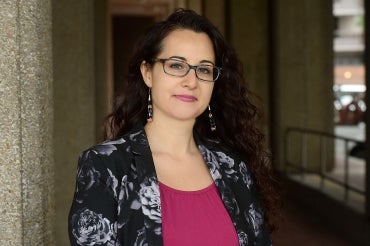OISE scholar Jennifer Brant sees crucial role for teachers in advancing Truth and Reconciliation in Canada

Published: November 2, 2018
Jennifer Brant joined the University of Toronto's Ontario Institute for Studies in Education in August as an assistant professor in the department of curriculum, teaching and learning. Brant belongs to the Kanien’kehá:ka (Mohawk Nation) and has family ties to Six Nations of the Grand River Territory and Tyendinaga Mohawk Territory.
With seven years of experience in university teaching and program co-ordination in Indigenous education, she is an accomplished Indigenous feminist scholar whose research focuses on Indigenous education and literature. She spoke recently to OISE's Kaitlyn Balkovec.
How would you describe your approach to teaching and learning?
I believe in teaching that is engaging, personally meaningful and speaks to the hearts and minds of learners. And I’m committed to responding to the Calls to Action put forth by the Truth and Reconciliation Commission of Canada.
What does this commitment involve?
I teach difficult topics such as the history of residential schools in Canada. I also incorporate lessons on recent issues that have led to the fractured relationship between Indigenous and non-Indigenous peoples in Canada. These include, but aren’t limited to: violence against Indigenous women and girls, institutional racism, cultural appropriation and discrimination against Indigenous children.
How do you prepare your classes for these challenging subjects?
I take special care to ensure all students feel the classroom is a safe space as they learn about this history and its ongoing effects. Because these topics can evoke strong emotions of frustration and guilt, it’s important that students feel empowered to participate in class discussion. I emphasize mutual respect and Indigenous teachings about bringing a ‘good mind’ to class so students can come to terms with these issues and consider their own role in reconciliation. I believe that change begins with education. For many students, this involves looking within and confronting preconceived notions and biases. Teacher candidates must consider their own identities as future educators who will need to teach in ways that respond to the commission’s Calls to Action.
You’ve said that Indigenous literature has been very important to you. How so?
One of the things I love about Indigenous literature is the authenticity of the stories. Reading Morningstar Mercredi's Morningstar: A Warrior's Spirit, and Katherena Vermette's The Break ignited something inside me. I came to understand my experiences as shared realities, and I yearned for more material that offered the same level of connection and familiarity. The stories take you on an emotional journey and are ultimately empowering: they illuminate the resilience of Indigenous womanhood.
What do you see as the broader impact of Indigenous stories?
For non-Indigenous readers, the stories are incredibly eye-opening because they offer insights into the lives of the authors that are strikingly different from the stories we tend to get from mainstream media outlets. I developed Indigenous women’s literature courses at Brock University to showcase the power of this type of literature as a teaching tool to enhance students’ capacity for intercultural understandings, empathy and mutual respect. This aligns with one of the commission’s calls to action.
How do you use literature in the classroom?
My courses position Indigenous literature as both window and mirror. For Indigenous readers who may find personal connections, the literature serves as a mirror that reflects their realities. Within that mirror, readers not only see the lingering effects of colonization but also resilience and personal triumphs. This has been described as healing and empowering. For non-Indigenous readers, the window allows a clear view that may promote cross-cultural understanding between Indigenous and non-Indigenous peoples and a desire to address issues of educational inequity for Indigenous students. The courses give students an opportunity, through literature, to make deeper connections to contemporary social justice issues. For some students, the mirror and the window may also prompt a desire to get involved in social change and to advocate for human rights that all individuals in Canada should have. These include access to safe drinking water, better roadways and equitable schools in First Nations communities. Others gain a clearer understanding of their role in reconciliation and the importance of implementing culturally relevant pedagogies in their own teaching.
What are you most proud of personally and professionally?
Personally: being a mother of my two boys. My cultural teachings tell me that our children choose their parents and I am truly honoured that they have chosen me. Professionally: balancing family, work and community engagement. That being said, I am continually striving to maintain this balance and I am fortunate to have been able to centre my children in some of my academic work: I write and teach about Indigenous motherhood as a starting place for creating, building and maintaining a nurturing and nourishing teaching and research environment.



